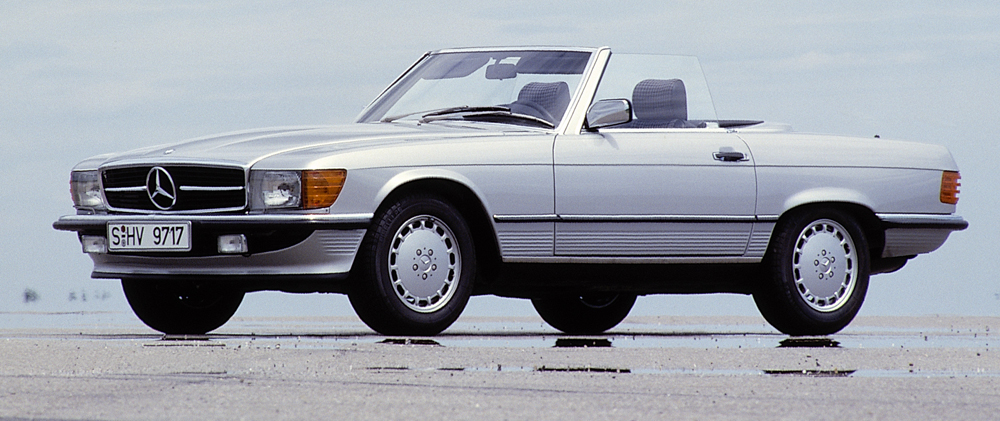
In April 1971, a new SL rolled out onto the highway, the Mercedes-Benz 350 SL. For the first time in the history of the model series an eight-cylinder power plant did duty under the long bonnet. From all sides it made the impression of a strong, self-confident, imposing open-top vehicle. Its parents also gave it an equally well designed, removable coupé roof for the road. Besides elegance and quality the body radiated safety, since the crash behaviour of the two-seater was far ahead of its time.
A hard decision
The decision to manufacture the R 107 series (for the first time an SL series received the internal designation “R” as in Roadster instead of “W” as in Wagen = car) was taken by the Board of Management after intensive debates on 18 June 1968. At issue was whether there should be a Targa roof version, i.e., one with a removable roof panel, instead of the fabric-topped variant, because owing to higher safety standards alarming news was to be heard from the USA regarding the licensing of open-top cars.
That a decision was finally made in favour of an open-top two-seater with a fabric roof and an additional removable hard top can be attributed to Hans Scherenberg, the head of Development, who fought tooth and nail for it: “The SL gave me great pleasure, but also caused me great trouble. This was no easy decision for us,” he summed up the decisive meeting.
The history of the roadster is intimately linked to that of the coupé. For the coupé question still remained unanswered. It was not decided that day. Discussion centred around whether one should additionally, and soon, make a four-seater sports coupé based on the R 107 series, or wait for the coming S-Class (W 116) to build it on that basis. But then a production model would not have arrived until much later, in the mid-1970s.
Karl Wilfert, then Head of Body Design in Sindelfingen, developed – pretty much on his own authority – a coupé based on the R 107 and presented it one day to the Board of Management as a “rough draft”. Rejected at first, Wilfert managed to push through his idea of a sports coupé with the tenacity which was so characteristic of him.
And so just six months after its première the SL was followed in October 1971 by a comfortable four-seater sports coupé, the 350 SLC, whose unconventional lines also found it many friends around the world in the course of the years. Internally the series was designated C 107 (the “C” stands for “coupé”). Up to the windscreen its appearance matched that of the open-top variant; behind the windscreen the overall height and length grew. A flat roof spanned the four-seater passenger compartment in a gentle curve, going over into a large and very steep rear window that arched in two directions. The boot lid was slightly convex in shape, unlike the SL’s.
In the side prospect the length of the coupé is documented, firstly, by the 360-millimetre longer wheelbase (2820 millimetres versus 2460), secondly by the line of the side windows. Without interfering B-pillars they were completely retractable, as is usual in a Mercedes-Benz coupé. The SLC’s drag coefficient was better than that of the SL so that the coupé attained the same performance despite an added weight of some 50 kilograms. A particularly noteworthy fact is that it fully lived up to its classification as a “Sports Coupé”, gaining wins for Mercedes-Benz in many rallies and long-distance races.
Safety as agenda
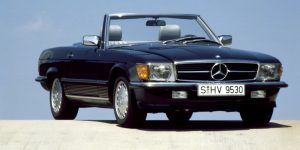 Béla Barényi’s safety concept with front and rear crumple zones and a rigid passenger cell found expression in the 107 series in a further developed form. The backbone of the R 107 is not simply a shortened and reinforced Saloon floor assembly, as in the predecessor, but an independent frame-floor unit with a closed transmission tunnel and box-shaped cross and longitudinal members which featured differing sheet metal thicknesses and a resultant carefully defined crumple pattern.
Béla Barényi’s safety concept with front and rear crumple zones and a rigid passenger cell found expression in the 107 series in a further developed form. The backbone of the R 107 is not simply a shortened and reinforced Saloon floor assembly, as in the predecessor, but an independent frame-floor unit with a closed transmission tunnel and box-shaped cross and longitudinal members which featured differing sheet metal thicknesses and a resultant carefully defined crumple pattern.
The SL definitely had to be an open-top car, and that being the case the only protection in a possible roll-over would be provided by the A-pillar plus windscreen. They were thoroughly redesigned and had 50 per cent more strength to show than in the previously-built version. In addition, to enhance its strength the windscreen was bonded into the frame. This resulted in a remarkable power of resistance in the roof-drop test with the result that it was possible to license the open-top car for the USA even without a Targa bar. To complete the logic the rear window of the hardtop was also bonded into its frame.
In the interior there were pioneering changes to report, as well. The hard dashboard made way for an ingenious sheet-steel design that yielded on impact both in the top section and the knee area and was foam-padded. The switches and levers were recessed. The four-spoke steering wheel based on the latest findings of accident researchers, was also new. The proven impact absorber was still in place, but the steering-wheel rim, spokes, padded boss and hub were covered with polyurethane foam. As further safety feature the fuel tank was no longer installed in the rear end but above the rear axle, protected against collision. From March 1980, the anti-lock braking system ABS was offered; from January 1982, also airbag and belt tensioner.
A bestseller right off the bat
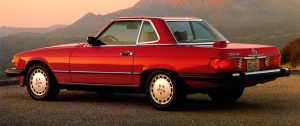 But it was not the safety aspects that motivated customers around the world to quickly reach for the new SL. It was the promise of an open-top automobile that was a successful piece of engineering all round – and it was in fact the only one of its kind offered in the USA over a period of several years . Its distinctive front end with the dominant SL face, the wide-band headlamps and grooved turn indicator covers had a powerful aura; the lines of the low silhouette were harmonious – soft top open or closed, or with hardtop. And the very slight inward curve of the boot lid, along with the concave hardtop, were reminiscent of “Pagoda” days. The wide-band tail lights with their ribbed surface not only were largely insensitive to soiling, but additionally gave the rear end a touch of vigour.
But it was not the safety aspects that motivated customers around the world to quickly reach for the new SL. It was the promise of an open-top automobile that was a successful piece of engineering all round – and it was in fact the only one of its kind offered in the USA over a period of several years . Its distinctive front end with the dominant SL face, the wide-band headlamps and grooved turn indicator covers had a powerful aura; the lines of the low silhouette were harmonious – soft top open or closed, or with hardtop. And the very slight inward curve of the boot lid, along with the concave hardtop, were reminiscent of “Pagoda” days. The wide-band tail lights with their ribbed surface not only were largely insensitive to soiling, but additionally gave the rear end a touch of vigour.
Extremely conducive to comfort and ease of operation was the easily and speedily operated soft top, a refined version of the “Pagoda” top. It took just 30 seconds to open or close it. Folded, it disappeared underneath a cover that was meanwhile customary in the SL series.
A number of details underscored the car’s safety aspirations. The seats were available from the start with head restraints, and seat belts also were included. Physical well-being and driver-fitness safety were served by the heating system with its very spontaneous response, supported by new air ducting in the doors. Newly developed wind-deflecting mouldings on the A-pillars, which also served to channel off mud-laden water in the rain, and dirt-repelling covers on the exterior mirrors enabled good visibility. They kept the side windows clean even in inclement weather. The windscreen wipers arranged closely to each other in the centre of the car swept a respectable 70 per cent of the windscreen area, were always optimally positioned in the flow of air and did not lift off even at higher speeds.
Engines with catalytic converter
 During its 18-year “production time” (which was not planned to last that long, but in the end was indeed successful), the R 107 was driven by a whole series of six- and eight-cylinder engines. Its model designations are accordingly quite varied.
During its 18-year “production time” (which was not planned to last that long, but in the end was indeed successful), the R 107 was driven by a whole series of six- and eight-cylinder engines. Its model designations are accordingly quite varied.
The eight-cylinder models were led by the 350 SL (1971 to 1980), whose 3.5-litre engine (M 116) already was known from the W 108, W 109 and W 111 series. The 147 kW (200 bhp) which it delivered at 5800 rpm helped the sports car, which weighed 1600 kilograms after all, to clock nine seconds for 0 to 100 km/h and reach a top speed of 210 km/h. The 350 SLC had identical performance figures.
From autumn 1971 onwards, the 450 SL was produced, initially for the US market. At 5000 rpm its M 117 engine delivered 132 kW (180 bhp) in the California version and 140 kW (190 bhp) in the version for the other states, and from 1973 on, and 165 kW (225 bhp) in the European version. Top speed was 215 km/h: it surged from 0 to 100 km/h in 8.8 seconds. In 1972, the 450 SLC, the corresponding coupé version, followed, with identical engine and identical performance. Prior to March 1973, both were destined exclusively for export to North America, after that they were included in the general sales range.
In July 1974, the SL model range was extended: the SL and SLC were now available as models 280 SL and 280 SLC with the 2.8-litre M 110 engine. It developed 136 kW (185 bhp) at 6000 rpm and had proven its reliability in the two years before in the “Stroke Eight” series W 114/115 and in the W 116-series S-Class. Both models had identical performance: the top speed was 205 km/h; they could sprint from 0 to 100 km/h in 10.1 seconds.
Thus three SL engines were now available to choose from – nothing unusual nowadays, but a real innovation for this model category in those days. Only the attentive observer could distinguish between the three variants: The 280 SL could be recognised by its tyres, narrower than those of the 350 SL and the 450 SL. In addition, the 450 SL featured a discreet front spoiler attached to the rear lower end of the front apron and which significantly increased the radiator’s air throughput.
Between November 1975 and February 1976, the fuel injection systems of all three engines were changed for better compliance with emission standards, which had meanwhile also become stiffer in most European countries. The electronically-controlled Bosch D-Jetronic was abandoned for the newly-developed mechanically-controlled Bosch K-Jetronic. The adaptation entailed minor losses in output in all three cases: in the 280 SL to 130 kW (177 bhp) at 6000 rpm, in the 350 SL to 143 kW (194 bhp) at 5500 rpm, and in the 450 SL to 160 kW (218 bhp) at 5000 rpm.
At the same time the compression ratios of the 2.8 and 3.5-litre engines were slightly reduced. In addition, the 3.5 and 4.5-litre engines were equipped with a contactless transistorised ignition system and hydraulic valve clearance compensation to facilitate maintenance.
The compression ratio of the 2.8-litre unit was raised to the old figure again in April 1978. With a few supporting measures the engine then regained its earlier power potential of 136 kW (185 bhp), which it now delivered already at 5800 rpm.
In September 1977, Mercedes-Benz launched the 450 SLC 5.0 with a V8 engine (M 117) enlarged to a displacement of five litres. A hidden innovation was the first-time application of hypereutectic cylinder contact surface machining, a special smelting process which made it unnecessary to insert cylinder liners. The engine delivered 177 kW (241 bhp) at 5000 rpm, good for 0 to 100 km/h acceleration in 8.5 seconds and a top speed of 225 km/h. The vehicle’s bonnet and boot lid were made of aluminium, and it had light-alloy wheels as standard. On the outside the 450 SLC 5.0 was recognisable by, among other things, a narrow spoiler on the rear end.
Revising the series
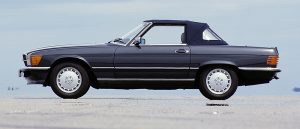 At the Geneva Motor Show in March 1980, Mercedes-Benz presented the SL and SLC in updated form. Their interior appointments, including the steering wheel were harmonised with those of the 126-series S-Class, and the engineering was brought up to the same level. The previous three-speed automatic transmission with torque converter was replaced with a four-speed variant. Models 280 SL and 280 SLC were given a five-speed manual transmission as basic equipment. In addition, the hardtop was now included in the standard specifications of the open-top variant. But above all the light-alloy eight-cylinder engines of the 126-series S-Class, slightly modified, made their arrival in the 107-series. The six-cylinder engine of the 280 SLC remained unchanged.
At the Geneva Motor Show in March 1980, Mercedes-Benz presented the SL and SLC in updated form. Their interior appointments, including the steering wheel were harmonised with those of the 126-series S-Class, and the engineering was brought up to the same level. The previous three-speed automatic transmission with torque converter was replaced with a four-speed variant. Models 280 SL and 280 SLC were given a five-speed manual transmission as basic equipment. In addition, the hardtop was now included in the standard specifications of the open-top variant. But above all the light-alloy eight-cylinder engines of the 126-series S-Class, slightly modified, made their arrival in the 107-series. The six-cylinder engine of the 280 SLC remained unchanged.
The new 500 SL, equipped with the 5.0-litre V8 (M 117) familiar from the 450 SLC 5.0, replaced the 450 SL and delivered an output of 177 kW (241 bhp) at 5000 rpm, to give the new top-of-the-range model a 0 to 100 km/h acceleration of 7.8 seconds and a top speed of 225 km/h.
Models 350 SL and 350 SLC were sent off into retirement after nine years of production. Their successors were the 380 SL and 380 SLC, whose 3.8-litre light-alloy engine (M 116), with 160 kW (218 bhp) at 5500 rpm, originated after the pattern of the five-litre unit, by enlarging the bore of the long-serving 3.5-litre V8 with grey cast iron cylinder block. Both models attained top speeds of 215 km/h and accelerated to 100 km/h from a standstill in just 9 seconds. From the outside the new models were almost indistinguishable from the previous models, except for the badge with the model designation. All three SL models had now a light-alloy bonnet and the discreet front spoiler familiar from the 450 SLC 5.0; the 500 SL was also given a light-alloy boot lid with a black plastic rear spoiler, already familiar from the five-litre coupé.
In autumn 1981, both V8 engines were thoroughly redesigned in the context of the “Mercedes-Benz Energy Concept” to reduce their consumption and pollutant emissions. Along with an increase in compression ratio the measures included camshafts with variable valve timing, air-bathed injection valves, and an electronic idling speed control. Owing to the altered camshaft tuning the maximum torque could be shifted to a lower engine speed range and, in the case of the 3.8-litre engine, even increased. This power plant underwent particularly far-reaching changes: to get a more favourable volume-to-surface ratio the bore was reduced and the stroke increased. The modified 3.8-litre V8 thus had a slightly larger displacement. In both eight-cylinders, in exchange, so to speak, for the improved economy, minor losses in power had to be accepted, output dropping to 150 kW (204 bhp) at 5250 rpm in the 380 SL and to 170 kW (231 bhp) at 4750 rpm in the 500 SL. As in the 126 series the final drive ratio was adjusted to the changed engine characteristics and made higher, from 3.27 to 2.47 in the 380 SL and from 2.72 to 2.24 in the 500 SL.
For the SLC Coupés these changes came too late, however: at the Frankfurt on the Main International Motor Show in September 1981, along with the “Mercedes-Benz Energy Concept” the 380 SEC and 500 SEC models of the C 126 series were presented, spelling retirement for the SLC models, which had been built for exactly ten years.
But even after ten years of production there was no thought of a replacement for the SL models; what’s more, four years after the Energy Concept was presented, they came in for extensive refinements, and so in September 1985, again at the Frankfurt show, a completely revised SL model range was introduced. The emphasis was on a restructured engine range. A discreet facelift, primarily recognisable from the front spoiler and wheels with aluminium rims (diameter: 38.10 centimetres), was also part of the package. The front axle was reworked and the brakes enlarged with fixed callipers. To prevent the cars from pulling to one side when braking, the steering offset was reduced.
A comprehensive facelift
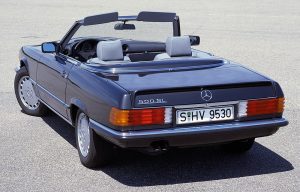 All engines were available in two versions: with a catalytic converter and slightly lower output, and as so-called catalyst retrofit version without a catalytic converter. The catalyst retrofit versions could be equipped later on with a catalytic converter, for example when the widespread supply of unleaded petrol was ensured, and had their ignition system, electronics and cable harness prepared for this.
All engines were available in two versions: with a catalytic converter and slightly lower output, and as so-called catalyst retrofit version without a catalytic converter. The catalyst retrofit versions could be equipped later on with a catalytic converter, for example when the widespread supply of unleaded petrol was ensured, and had their ignition system, electronics and cable harness prepared for this.
A newly-designed 3.0-litre six-cylinder engine (M 103) which had made its first appearance in the 300 E of the mid-range W 124 series nine months earlier replaced the tried and tested 2.8-litre engine, as it had already done previously in the respective S-Class Saloon. As a result the 280 SL was discontinued, and after a 22-year interruption there was again a sports car with the magic model designation 300 SL. It delivered an output of 138 kW (188 bhp) at 5700 rpm without catalytic converter (top speed: 203 km/h; 0 to 100 km/h in 9.6 seconds) and 132 kW (179 bhp) with catalytic converter (200 km/h; 9.9 seconds).
A new addition to the range was the 420 SL with the 4.2-litre V8 engine (M 116), which delivered 160 kW (218 bhp) at 5200 rpm without a catalytic converter and 150 kW (204 bhp) with one. It was created by adopting the bore of the original 3.8-litre engine and combining it with the stroke of the “Mercedes-Benz Energy Concept” 3.8-litre engine, and it now replaced that unit in the SL, the S-Class Saloon and the SEC Coupé. The 420 SL accelerated from 0 to 100 km/h in 8.5 seconds (with catalytic converter: 9 seconds) and reached a top speed of 213 km/h (205 km/h).
The 5.0-litre engine (M 117) was modified, too; with catalytic converter operation in mind it now had an electronic ignition system and the electronically/mechanically controlled Bosch KE-Jetronic injection system, delivering 180 kW (245 bhp) at 4750 rpm. With a catalytic converter the output was 164 kW (223 bhp) at 4700 rpm. These values helped the 500 SL reach a top speed of 225 km/h (with catalytic converter: 215 km/h) and accelerate from 0 to 100 km/h in 7.3 seconds (7.8 seconds).
The most spectacular new development in the engine range was a 5.6-litre eight-cylinder engine (M 117), which was created by increasing the stroke of the 5.0-litre V8 and which gave the SL an output of 170 kW (231 bhp) at 4750 rpm. The 560 SL was reserved for the USA, Australia and Japan export markets. Fitted with an emission control system in the US version it had a top speed of 223 km/h and sprinted from 0 to 100 km/h in 7.7 seconds.
Production of the R 107 series ended in August 1989, more than 18 years after start-up of the 350 SL. This SL series set an internal record that will probably never be broken: in the entire history of the company no other passenger car series has ever been produced over such a long period, with the exception of the G-Class. All told, in Sindelfingen 237,287 open-top cars were built, a number which impressively demonstrates the great popularity of the 107 series. Of the coupé a total of 62,888 units were built from 1971 to 1981.
Highlights of the Mercedes-Benz SL, R 107 series
- Coupés of the SLC series available until 1981 parallel to the open-top version
- The first SL with eight cylinders
- Further developed safety body
- Frame floor assembly with sheet metal of different thicknesses and a resulting carefully-defined crumple behaviour
- Rugged roll-over protection: high-strength A-pillars and windscreen frame with bonded glass for greater stability
- Special air ducting in doors ensures low soiling of side windows and exterior mirrors
- Bosch K-Jetronic contactless transistorised ignition, hydraulic valve clearance compensation (1975)
- First SL with exhaust gas catalytic converter (1985)
Production years…..(1971-1989)
Production figures for Mercedes-Benz SL, R 107 series and SLC, C 107 series
A total of 237,287 open-top two-seaters produced in 18 years

Gallery


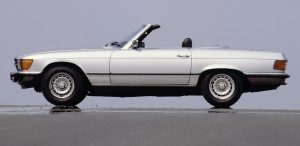
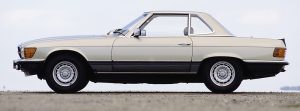
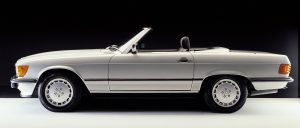

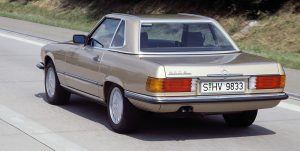
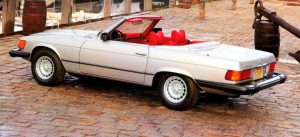

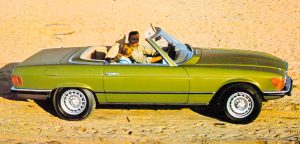
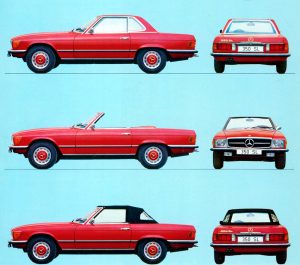
You must be logged in to post a comment.